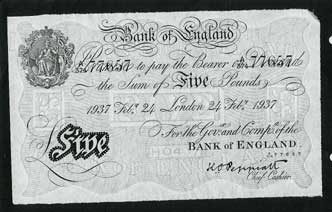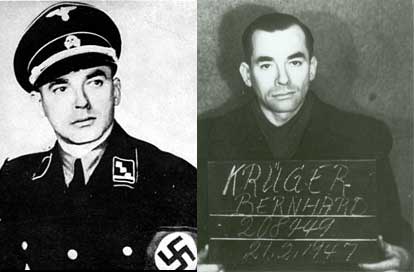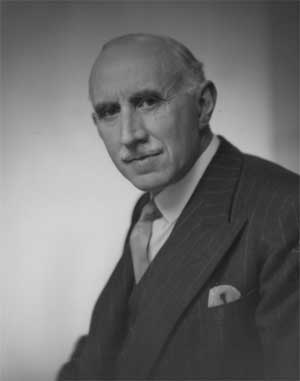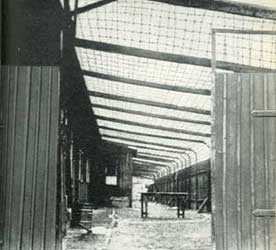 |
| A counterfeit five-pound note produced by the Nazis. It's almost impossible even for an expert to distinguish a top-quality Bernhard counterfeit from a real note.(Courtesy of Colin Narbeth & Son, London.) Click
to Enlarge. |
Krueger's
Men:
The Secret Nazi Counterfeit Plot and the Prisoners
of Block 19
This tale of true crime, which inspired the Academy Award winning film, "The Counterfeiters" is told here in full for the first time, stripping away the myths and illuminating the ironies of the scheme known as Operation Bernhard, which was named for the SS officer who ran it. It also contains a political allegory for today. As the greatest counterfeiting operation in history took shape inside an authoritarian government, a tightly knit, self-reinforcing group pressed ahead with only the most perfunctory internal discussion. The result was a technical success but a strategic flop and, in the crowning irony, an espionage blowback. Contrast that with the vigorous discussion inside Allied councils on whether to wage their own counterfeit war on the enemy. Even the most clever and imaginative military plans demand scrutiny through the critical questioning essential to democratic government.
Only a fortnight after the start of World War II, at a meeting
that has remained a secret for more than half a century,
officials of German finance and Nazi espionage approved an
audacious plot to bring down the world's financial system.
Hundreds of millions of forged British pounds were to become
a weapon of war. Operation Bernhard not only became the greatest
counterfeit scheme in history but the most wide-ranging and
bizarre, with its own gallery of rogues.
 |
| Bernhard Krueger as a young SS officer (left), and in a mug shot taken by the British after the war. Photo Credit: British National Archives |
Major Bernhard Krueger, a meticulously correct SS engineer,
ran a production line of Jewish prisoners in Sachsenhausen
concentration camp near Berlin. The millions of forged notes
they printed were laundered through a Nazi confidence man
with the help of Jewish agents who concealed their origins.
Toward the end, one of Europe 's most accomplished professional
forgers, the only career criminal in the operation, was brought
in to counterfeit dollar bills.
In London, the arrogant grandees at the Bank of England
could not believe their pound notes could be forged with
such expertise and in such quantity. Even George Soros, the
great speculator who broke the Bank of England fifty years
later, almost got bilked as a boy on the Budapest black market.
In one of the crowning ironies of many, after the war Golda
Meir protected a millionaire Jewish money-launderer from
British authorities in what was then known as Palestine.
 |
| Sir Kenneth Peppiatt, chief cashier of the Bank of England, whose signature appeared on every pound note--real and forged." (Bank of England photo) |
The plot was hatched in Berlin on September 18, 1939, behind
the imposing stone facade of what had once been Kaiser Wilhelm's
Finance Ministry. Walther Funk, a pudgy former financial
journalist whose principal task was keeping German industry
in Hitler's camp, was the only one to register the least
objection because he feared the counterfeit notes would upset
his task of milking Hitler's conquered territories. Josef
Goebbels, Hitler's propaganda minister, was not present but
feared the "grotesque plan" might be turned against
Germany 's own fragile finances by the Allies. In fact, Winston
Churchill and Franklin D. Roosevelt toyed with the idea of
counterfeiting enemy currency but their advisers rejected
it.
Nevertheless, the second-rate minds of Nazi espionage believed
they could weaken the pound as the trading standard and store
of value underpinning the British Empire. Bullies and incompetents
were at first put in charge of the operation. After several
false starts, Krueger, a textile engineer, figured out how
to match the paper, printing, and design of the impressive
British notes. He found his forgers in Jewish death camps
on the orders of SS Reichsfuehrer Heinrich Himmler. Some
were plucked from Auschwitz by Krueger himself, who courteously
addressed them with the formal German Sie.
The SS planned to keep the operation secret by killing them
when the job was done. The prisoners worked with the knowledge
that they were marked for death when they had finished their
jobs. " From the start, they wondered whether they should
stretch out their work and risk execution for sabotage, or
perform efficiently and thus hasten their own deaths. No
one ever knew for sure where Krueger stood, but by keeping
the operation going, he kept himself from being sent to the
Russian front. What all these men said and thought as they
lived under this sword of Damocles makes chilling, personal
drama.
From 1942 to 1945, the Germans forged more pound notes than
all the reserves in the vaults of the Bank of England--132
million pounds, equal to about 15 per cent of all genuine
notes in circulation and enough to cast suspicion on all
of England 's paper money. They were worth $650 million at
the wartime rate of exchange and six or seven billion dollars
in today's money. By 1943 the Luftwaffe was almost kaput,
so instead of pursuing their original goal of dropping the
counterfeits on England to cast suspicion on real pound notes,
the SS used the fakes to finance its own espionage service--whose
discoveries Hitler ignored like all bad news--and to undermine
and eventually absorb the German military's own intelligence
corps. The SS specialized mainly in dirty tricks and, true
to the nature of the Nazis' gangster regime, in skimming
money to enrich themselves. So many counterfeit pounds flooded
the black markets on the European continent and North Africa
that Britain's currency came under widespread suspicion
abroad, and its value plunged.
 |
| This undated and uncredited photo showing Barracks 18 and 19 enmeshed in barbed wire is believed to be in the Archives of the former Soviet Union. |
The British defense was as weak as it was unprecedented.
Normally nations at war guard their currency by prohibiting
its export. Instead, the British imposed a wartime blockade
on bringing pounds into the country to prevent
the counterfeits from infecting the economy. Scotland Yard
was powerless, and so was Interpol. Its Vienna headquarters
had fallen into Hitler's hands when he swallowed Austria
in 1938. The Nazis even fooled Swiss bankers, whom the British
left swinging in the wind rather than let their secret defenses
against counterfeits become known.
By the end of the war, Operation Bernhard had left its imprint.
Through one of the Jewish money launderers, the Jewish underground
passed on thousands of counterfeits to help the ingathering
of exiles to Palestine and the purchase of war materiel for
the nascent Israeli army. The Bank of England was so embarrassed
by the massive counterfeit that it not only burned the fakes
but some of its files. In the continuing and futile search
for Nazi loot and bank records deep in the Alpine lakes where
the SS dumped millions of forged bills, the financial and
political ripples continued into this century.
Krueger's Men is based on interviews with survivors, unpublished
memoirs, and previously classified files in official archives,
some of which are reproduced on this website. False leads
have been floated by Holocaust hucksters and false information
on the internet. Film and print versions tell only part of the story,
and some of that incorrectly. It now can be told in full
from the inside, with its characters drawn from life. Like
much Nazi lore, it stimulates the perverse fascination with
Nazi totalitarianism and its infantile fantasies of absolute
power, and it teeters on the edge of life and death to its
final moments.
|